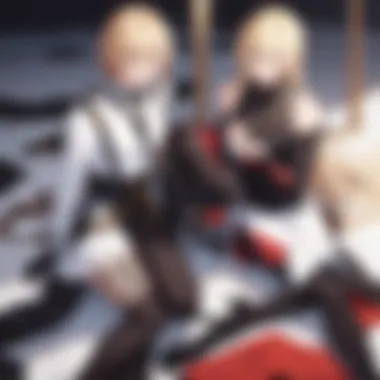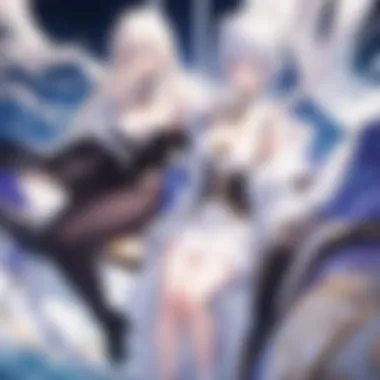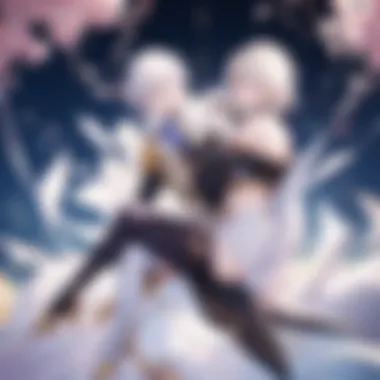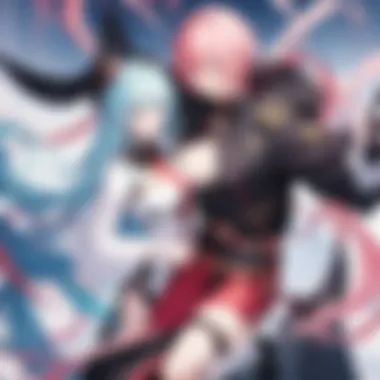Exploring the Omegaverse in BL Manga: A Deep Dive


Intro
The Omegaverse is a compelling sub-genre within BL manga that has gained significant traction in recent years. It introduces readers to a unique universe characterized by hierarchical dynamics seen in terms of alpha, beta, and omega roles. Such designations reflect more than mere labels; they initiate complex themes related to identity, power dynamics, and social constructs in relationships.
Understanding the Omegaverse not only involves knowing its roots and gender implications but delves into the cultural significance it holds across different contexts. This article offers a deep dive into these dynamics and assesses the factors behind the proliferation of this genre, both in Japan and internationally.
Episode Reviews
Though the Omegaverse in manga doesn't follow a strict episodic format, specific series often encompass thematic arcs that mirror episodic storytelling. The focus on key moments and developmental stages can serve a similar purpose. Reviewing these prevailing series allows an exploration into pivotal events and themes that define the genre’s narrative structures.
Summary of Selected Series
Omegaverse series like
Prologue to Omegaverse
The discourse surrounding Omegaverse in BL manga represents a fascinating intersection of niche subculture and mainstream narrative exploration. Understanding this sub-genre is critical because it encapsulates more than just romantic inclinations. Omegaverse intricately explores identity, societal norms, and emotional experiences through its unique character dynamics and storylines. Blending speculative fiction with elements of social commentary, the Omegaverse invites readers to challenge preconceived notions of gender roles, relationships, and power structures.
Definition and Concept
Omegaverse is defined by its structured roles often categorized into three main classifications: Alphas, Betas, and Omegas. Each of these roles carries distinct attributes and traits. Alphas, typically seen as dominant figures, are often characterized by their strength and leadership qualities. Betas serve as the neutral mediators, appearing less frequently in narratives, embodying a balance between Alphas and Omegas. Omegas, conversely, are usually more submissive, projected as nurturing and often depicted to experience particular biological functions. This dynamic forms the basis for the rich interpersonal relationships portrayed in various series, allowing for explorations of themes like power, vulnerability, and connection.
While Omegaverse primarily began within the realm of fan fiction, its integration into BL manga signifies a broader acceptance and proliferation of the genre. Key to this genre's attraction is how it stretches traditional boundaries, allowing freedom for characters to adapt and challenge their assigned roles. The ability to switch dynamics enhances complexity and adds layers to both plot and character development.
Historical Origins
The origins of Omegaverse can be traced back to fan fiction, growing out of science fiction and fantasy circles in the early 2010s. At that time, writers played with the conventions of various fandoms, creating a blend of societal hierarchy and fictional biologies that eventually made its way into other fandoms and formats.
Initially inspired by tropes within existing media, such as werewolf mythology, the Omegaverse quickly differentiated itself by establishing a distinct set of rules governing character interaction. This framework resonated with many writers and readers alike, facilitating unique storytelling possibilities.
As Omegaverse narratives proliferated, they gradually transitioned to BL manga, where more authors explored the themes without the constraints often faced in Western narratives. The marriage of traditional manga aesthetics and storytelling with the alternative dynamics of Omegaverse creates a compelling foundation for discussion, hence igniting further interest in the genre and its potential.
The following sections of this article will delve deeper into structural elements, common themes, cultural contexts, and future trends in Omegaverse as seen in BL manga.
Structural Elements of Omegaverse
Understanding the structural elements of Omegaverse is critical for anyone delving into this intriguing sub-genre of BL manga. These elements shape narratives and define character relationships in profound ways. This section delves into two primary dynamics: the roles of Alphas, Betas, and Omegas, and the hierarchy that typically governs their interactions.
Alpha, Beta, and Omega Dynamics
The character roles in Omegaverse are not merely labels; they deeply influence personalities, power struggles, and relational approaches.
- Alpha: This role often embodies strength and authority. Alphas are frequently portrayed as dominant figures, leading with aggression and charisma. Their capacity to protect or control makes them central to many narratives. They often seek mates to assert their status.
- Beta: Betas serve a more neutral role. Lacking the extreme traits of Alphas and Omegas, they act as stabilizing forces within the narrative. They are adaptable characters who may play supporting roles, providing harmony and balance amidst intense conflicts.
- Omega: Omegas are depicted as nurturing but often vulnerable so they can face challenges. Known for being the subject of others' desires, they may also grapple with societal expectations. Relationships with Alphas often explore themes of submission and control, piercing into the deep emotions of attachment.
This detailed categorization promotes diverse stories, making interactions between characters like thrilling, complex shows of relationship dynamics.
Hierarchy and Social Structure
A key feature of Omegaverse is its distinct hierarchy and social structure, providing profound insights on power and role interactions.
- Social Stratification: Alphas frequently occupy the upper echelons of society, with their status influencing all aspects of interpersonal relations. Betas fit into various societal roles and often provide grounded observations of the world around them. Omegas are usually marginalized within this framework, reflecting societal biases and expectations.
- Pack Dynamics: Characters collaborate in groups, known as packs. These packs signify both social groups and familial ties between different roles, creating rich grounds for conflicts, alliances, and emotional bonds.


“The intricate weave of hierarchical positioning reflects broader themes of dominance, vulnerability, and societal pressures, paving the way for complex storytelling.”
Understanding these structural elements provides a robust framework for interpreting the narratives often traversed in Omegaverse fully.
Themes in Omegaverse BL Manga
Themes in Omegaverse BL manga form a crucial part of its appeal and narrative depth. Understanding these themes offers insights into the series' cultural significance and the way they reflect societal attitudes. The exploration of identity, power dynamics, and reproductive issues are central to comprehensive analysis. This section reveals how these themes shape characters' experiences and connection with the readers.
Identity and Self-Discovery
In Omegaverse narratives, the theme of identity and self-discovery is pivotal. Characters often grapple with their inherent roles as alphas, betas, or omegas. Each role influences not only their societal standing but also their personal journey toward understanding who they are.
Characters frequently confront internal struggles as they navigate societal expectations and their personal feelings. For example, an omega might deal with the stigma attached to their identity while simultaneously learning to embrace it. This journey toward self-acceptance can resonate deeply with readers who also face identity struggles in their lives.
Moreover, stories might highlight how relationships help these characters craft their identities. In this way, Omegaverse BL manga does not only provide entertainment. It also offers commentary on the complexity of finding oneself amid societal pressures.
Power Dynamics and Relationships
Power dynamics serve as a glaring theme throughout Omegaverse stories. The interaction among alphas, betas, and omegas can reveal much about ambition, authority, and vulnerability. These roles establish a social hierarchy that influences character relationships. Omegaverse narratives naturally reflect broader social issues related to power and control.
For instance,alphas often dominate, asserting authority over betas and omegas. However, power can be portrayed as multifaceted, even reversible. The dynamics shift when an omega, who derives significant strength from emotional intelligence, challenges societal norms. Such plotlines enable contrasting views on masculinity and power, enriching character development.
In the images presented visible between relationships also can comment on gender dynamics through their various interactions. These connections often run deep, with respect and mutual understanding emerging from misunderstandings.
Fertility and Reproductive Issues
Fertility and reproductive issues form another cornerstone in Omegaverse BL manga, dealing not just with relationships but also with personal desires and societal implications. The biology in this universe adds layers to the understanding of family structures and personal choice.
Depictions of pregnancy, often intrinsic to angst-filled narratives, provoke serious reflection on fertility symbolism in society. Across narratives, omegas may have their role configurations disputed, altering their journey to mate, nurturing, or facing productivity pressures from external sources. These themes underscore not only unfulfilled emotional needs but also mechanical representations of societal judgments regarding marriage and family.
As fertility discussions unfold, they may symbolize human relationships by mirroring real-world challenges not usually addressed explicitly in mainstream manga.
In the realm of Omegaverse, creators craft different portrayals of gender roles through their engagement in unsettling reproductive tropes. This interaction opens new avenues for readers to sequentially digest gender existence.
In summary, the themes of identity and self-discovery, power dynamics, and fertility enrich Omegaverse narratives. They invite diverse readerships to connect with characters amid unique emotional struggles and opportunities, encouraging reflections on gender norms and personal growth.
Cultural Context of Omegaverse
The cultural context of Omegaverse serves as the backbone of its relevance within BL manga. It provides readers with insight into how traditional societal norms are challenged and reimagined through a unique lens. Оmegaverse narratives reflect a deeper examination of hierarchy, identity, and relationships that resonate with contemporary issues in both Japan and globally. These stories serve not just as entertainment but as a means of exploring critical social themes.
Japanese Cultural Influence
Japanese culture heavily influences the Omegaverse genre through various aspects. The gender roles historically found in Japanese society have been subverted and reinterpreted in Omegaverse narratives. The traditional constructs of masculinity and femininity allow for creative expression in which characters adapt and reject typical social expectations.
Blending the real with fantasy, Omegaverse draws upon rich Japanese storytelling traditions. This creates characters and plots that explore these nuanced roles deeply and thoughtfully. Themes of nurturing and power, alongside identities that officials typically dismiss, intersect within this framework.
Importance of LGBTQ+ Representation: The inclusion of diverse sexual orientations and dynamics provides a voice for those who may remain unheard in mainstream narratives. Omegaverse adds depth to the portrayal of sexual relationships and identity exploration. It facilitates discussion around gender norms, ultimately fostering an environment of inclusivity.
Global Reception and Adaptations
As Omegaverse gained traction, its impact extended beyond Japanese borders. Readers worldwide recognized and resonated with the themes prevalent in the genre. The narratives explore universal questions around identity and relationship dynamics, making them accessible to an international audience.
An increase in translations and localized adaptations shows this trend. Fan translations allow readers to experience the content that might otherwise be limited by language barriers. Additionally, the genre's popularity has led to adaptations in various forms, including webcomics and animated series.


Response Varied:
- While some celebrate Omegaverse narratives for their innovative exploration of themes, others critique them for perpetuating stereotypes or introducing problematic elements. Each interpretation broadens the discourse around Omegaverse and its implications.
- The intersection of global and Japanese influences creates a rich tapestry through which readers consider different cultural norms and challenges. Readers outside of Japan engaged in interpretative fandom let new interpretations flourish in fan art and discussions on platforms like Reddit, deepening the conversation around Omegaverse in new cultural contexts.
The Omegaverse sub-genre, while rooted in Japan, has become a cultural phenomenon appreciated by audiences worldwide, showcasing the power of storytelling in shaping discussions around identity and relationships.
Popular Titles and Authors
The exploration of popular titles and their authors in the Omegaverse within BL manga provides valuable insights into the genre's significance and appeal. Understanding rich narratives and influential creators allows readers to appreciate cultural nuances and storytelling techniques that shape this sub-genre. These works are not merely stories; they reflect complex themes of identity, power dynamics, and societal constructs through their engaging characters.
Noteworthy Manga Examples
In evaluating best-known manga, several standout works illustrate the key characteristics of the Omegaverse. Noteworthy titles include:
- Junjou Romantica by Shungiku Nakamura: This series is one of the earliest mainstream BL works that incorporates elements of the Omegaverse. The intricate relationships and emotional narratives establish a compelling foundation for other works that followed.
- Free! (Fujoshi no Koroshimai) by Hiroshi Masumura: A lighter take yet still resonant, this manga encapsulates Omega dynamics through its character-driven plot, embodying serious themes without sacrificing accessibility.
- Fate/Stay Night (with otome drift): Fusing various manga elements, it dives deep into the intertwining fate of characters that operate within Alpha and Omega frameworks, proving to be both popular and impactful.
- Tsuki no Katsubo by Ru Soshin: This title further deepens Omegaverse's exploration with universal questions about destiny and choice. It is indicative of how narratives evolve in the genre, touching on personal insecurities amid relational complexities.
These examples underscore how diversity in narrative styles enriches the Omegaverse. The manga resonates with audiences, contributing to their lasting popularity and widespread fandom.
Influential Creators in the Genre
Several creators have played a pivotal role in shaping Omegaverse narratives. Their unique perspectives and storytelling flair have contributed extensively to the genre's evolution:
- Aymeric & Toni Jo: Known for blending deep emotional comprehensions with stark characterization; their works invite readers to experience the intertwining realities of the Omegaverse.
- Nakamura Asumiko: They have skillfully crafted protagonists facing society-based dilemmas. Their emphasis on personal struggles complements the audience's understanding of various identities within the Omegaverse.
- Pachypodium: A relatively newer figure yet impactful, Pachypodium involves elements of mythology juxtaposed against modern culture, attracting a diverse audience across different demographics.
Finale
All these titles and creators bring a variety of perspectives to the Omegaverse, further highlighting its themes and cultural relevance within the broader manga landscape. They not only offer engaging stories but also challenge readers to think critically about the dynamics reflected in these narratives.
Fan Communities and Interactions
Fan communities play a pivotal role in shaping the Omegaverse sub-genre within BL manga. Their enthusiasm and creativity foster a dynamic environment where readers and artists engage directly with the narrative themes and characters. These interactions not only enhance individual experiences but also contribute to the broader cultural significance of the Omegaverse genre.
The emergence of online platforms has transformed the way fans communicate. Forums such as Reddit offer spaces to discuss plot developments, share personal interpretations, and analyze character growth. This exchange of ideas allows fans to hold nuanced discussions about the complex themes featured in Omegaverse narratives, such as identity and power dynamics. While participating in these communities, readers connect with others who share similar interests, creating a sense of belonging that enhances their engagement with the manga.
“Fan communities are crucial in developing a deeper understanding of narrative nuances in Omegaverse manga. They promote thoughtful conversation and foster a shared culture.”
Online Platforms and Forums
Online platforms and forums serve as essential tools for fans to connect and critique. Websites like Tumblr and Twitter also contribute significantly to the conversation by enabling real-time updates and discussions. Many creators use these platforms to interact with their audience, leading to a more collaborative creative process. Established communities not only discuss existing works but also predictions for future plots and characters’ arcs.
Art and Fan Fiction Contributions
Art and fan fiction are vital components of the fan community's engagement with Omegaverse themes. Artists often create original content based on existing characters, breathing new life into familiar narratives. Their work serves to enrich the overall story, allowing fans to explore elements outside the official manga. Fan fiction operates on a similar premise, where writers expand on known plots or re-characterize personalities in ways that provoke thought and discussion.
These contributions build a bridge between the source material and the audience, creating a tapestry of interpretations and adaptations. Moreover, they reflect the enduring appeal of the Omegaverse narratives, underscoring how deeply fans resonate with the themes of the genre. Many forums encourage users to create and showcase their works, fostering not just consistency in narrative but a proliferation of creativity that extends far beyond the original intent.
Such community engagement goes a long way toward comforting fans, offering affirmation for diverse expressions relating to Omegaverse themes. By participating in such activities, fans deepen their connection to the genre and influence its future direction.
Criticisms and Controversies
Stereotypes and Misrepresentation
The Omegaverse genre in BL manga often faces sharp criticism for perpetuating stereotypes related to gender and sexuality. The rigid classifications of characters as Alphas, Betas, or Omegas can simplify overly complex human identities into broad strokes. Critics argue that this binary approach fails to represent the diversity that exists in real life.


Some analysts discuss the portrayal of Omega characters, who are frequently depicted as submissive and passive. This representation can lead to misunderstandings about male vulnerability and healthily explored relationships. Furthermore, the inclination of some creators to reinforce traditional gender norms raises concern about whether these narratives might actually contribute to harmful attitudes in society.
The intersection of sexuality and the aforementioned roles can further complicate perceptions. Many authors interchange traits associated with traditional male and female roles while relying on fantasy settings. As a result, readers might conclude that such dynamics are natural or expected within society.
Importantly, discourse around these stereotypes extends to how mixed messages about masculinity and femininity resonate with specific audiences. Fans often engage actively, commenting or creating content reflecting their own views about gender roles, provoking discussions around modern masculinity especially.
Debates on Consent and Agency
Another significant area of critique revolves around the themes of consent and agency present in Omegaverse narratives. Situations illustrated range from consensual relationships to problematic scenarios where consent is disregarded or seems to confuse readers. The power differentials present in these dynamics raise questions that many enthusiasts ponder, particularly in light of evolving cultural norms regarding sexual autonomy.
In many stories, the necessity for Omega characters to submit due to biological dictates sparks discontent. This aspect can trivialize authentic conversations around consent, posing risks in a romantic context. Critics emphasize that the glorification of forced dynamics, even in fiction, may normalize dangerous behavior or lack of agency outside the pages.
The community response varies widely. Some oppose these narratives fiercely, calling for responsible writing that embodies mutual respect. Others enjoy the fantasy yet posit it as a harmless escape from reality. Knowledge about these debates allows readers to understand their own engagement better while promoting critical conversations surrounding consent.
The representation of consensuality in Omegaverse BL poses intricate questions about power dynamics and expectations— shimming the October discussions through fans' wide spectacles.
Ultimately, both stereotypes and consent concerning the Omegaverse invite necessary critiques, as they reflect broader societal views toward gender, sexuality, and relationships. Addressing these issues is essential not only for advancing literary quality within the genre but also for maintaining a respectful exploration of human connections.
Future Trends in Omegaverse BL Manga
The landscape of Omegaverse in BL manga is continually evolving. There is a growing interest in exploring new narratives and expanding thematic elements. Understanding future trends is essential for various stakeholders, from readers to creators and critics. These trends can shape what readers can expect going forward in this unique sub-genre.
Evolving Narratives
Omegaverse narratives have traditionally focused on the premise of hierarchical society structured by alpha, beta, and omega roles. However, as cultural perceptions shift, so does the storytelling approach. The future is likely to see a departure from deterministic character arcs. Instead, stories may concentrate on more complex character development.
New plotlines could delve deeper into personal journeys of self-discovery. They will also highlight emotions and motives beyond the roles established in the Omegaverse framework. Emotional authenticity can resonate with the audience on many levels.
- Cross-generational implications of social roles will likely be reflected in fresh stories, appealing particularly to younger readers.
- Themes surrounding mental health may gain traction, adding depth.
As media continues to expand representation, new and refreshing narratives are expected. Trends may include serialized storytelling that engages readers long-term,and episodic transformations that break the traditional style. These evolved narratives may not only preserve the essence of the Omegaverse, but also make it relevant to contemporary societies.
Potential for Cross-Genre Exploration
The flexibility of the Omegaverse allows it to seamlessly integrate with other genres. This cross-genre potential can breathe new life into narratives. Combining Omegaverse storylines with themes common in fantasy, science fiction, or even romance opens new narrative pathways.
This blurring of lines between genres can showcase:
- Vampires and Supernatural Horror: Evoking question of existence and power. The struggle of dominating espirit or awaiting pheromones becomes palpable in these scenarios.
- Apocalyptic Frameworks: Where alpha, beta, and omega dynamics serve as an exploration of survival in harsh conditions, readers can expect emotionally taxing yet rewarding storylines.
- Realism and Slice-of-Life: Readers may align more closely with narratives exploring everyday dynamics within the Omegaverse.
These explorations are not merely artistic. They can enhance accessibility, allowing newcomers unfamiliar with Omegaverse to enter the fold without initial biases. Conclusively, there exists significant benefit from charting unexplored territories while holding firmly to the Omegaverse's fundamental aspects.
Insight: As genres blend, narratives can draw readers from different fandoms, enriching community interaction and engagement further.
Closure
Summary of Key Themes
Omegaverse in BL manga presents a unique combination of elements that work together to carve out a distinct narrative space. Key themes include the intricate dynamics between Alphas, Betas, and Omegus. These dynamics lead to explorations of identity and self-discovery. Social hierarchies also come into play, influencing relationships and power dynamics. Furthermore, recurring elements like fertility and reproductive issues reflect broader societal conversations, infusing the storytelling with depth and resonance.
The narratives often go beyond fantasy, probing real-life themes grounded in personal fighting acceptance and the struggle against societal norms. Understanding Omegaverse sequences can also add layers to how we see character relationships unfolding in various social contexts. Overall, readers are provided with population that harmonizes affection, dominance, and vulnerability, presenting a comprehensive picture of interactions.
Final Thoughts on Omegaverse's Impact
The impact of Omegaverse proliferates well beyond the pages of manga. This sub-genre reigns in fan communities, envisioning new interpretations and discussions, adding complexity to the narratives. In examining conventional gender roles, Omegaverse challenges norms. This sphere has created dialogues about consent and agency, which resonate in modern society.
The global reach of this genre cannot be overlooked. It has sparked collaborations and was greatly acknowledged across cultures. These combinations showcase adaptability and the continuous growth of storytelling methods. From fanfictions to original pieces by various authors, Omegaverse has sparked interest, curiosity, and discussion.
A deep exploration of its themes reflects its worth. In a world increasingly questioning power constructs, Omegaverse maintains an authenticity that resonates with its readers’s aspirations for more vibrant representation.*







